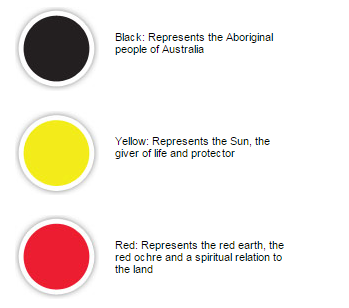Unfurling the Colours: Understanding the Significance of Aboriginal Australian Flags
Unfurling the Colours: Understanding the Significance of Aboriginal Australian Flags

The Aboriginal Australian flag, a powerful symbol of resilience, identity, and cultural heritage, proudly waves across the nation, representing the rich tapestry of Indigenous Australian life. Its vibrant colours, carefully chosen to embody specific meanings, tell a story that spans millennia, echoing the struggles, triumphs, and enduring spirit of the First Peoples of this land.
This article delves into the profound symbolism behind the Aboriginal Australian flag, exploring the individual meanings of each colour and how they collectively represent the unique journey of Aboriginal Australians. By understanding the flag’s colours, we gain a deeper appreciation for the history, culture, and aspirations of this vital part of Australian society.
Related Articles: Unfurling the Colours: Understanding the Significance of Aboriginal Australian Flags
- The First Australians: Uncovering The Rich Tapestry Of Indigenous History
- The Nomadic Spirit: How Long Do Aboriginal Tribes Stay In A Single Place?
- A Journey Through Time: Unveiling The Secrets Of Tontem Chapel
- Reclaiming The Past: Navigating Ancestral Land Rights In Canada
- The Enduring Legacy: How Aboriginal Beliefs Like The Dreaming Shape Contemporary Society
The Journey of the Aboriginal Australian Flag
The Aboriginal Australian flag, officially adopted in 1971, was designed by Harold Thomas, an artist and activist from the Luritja people of Central Australia. Thomas’s creation was a culmination of years of discussion and collaboration within the Aboriginal community, reflecting a shared desire for a unified symbol to represent their unique identity and heritage.
The flag’s design was inspired by the ancient stories and traditions of Aboriginal Australians, drawing upon the colours and patterns found in their art, ceremonies, and land. Each colour holds a distinct meaning, collectively weaving a narrative of strength, connection, and hope.
Black: Representing the Aboriginal People
The bold black colour at the top of the flag represents the Aboriginal people themselves. It symbolizes their deep connection to the land, their enduring spirit, and the strength they have drawn from their ancestors. Black, a colour often associated with power and resilience, reflects the Aboriginal people’s unwavering resistance and their ability to thrive despite adversity.
The black colour also pays homage to the vast and ancient landscape of Australia, where Aboriginal people have lived for tens of thousands of years. It acknowledges their profound knowledge of the land, their connection to its natural elements, and their deep understanding of its intricate ecosystems.
Red: Honouring the Blood of Aboriginal Australians
The red stripe running through the middle of the flag represents the blood of Aboriginal Australians, both literally and metaphorically. It symbolizes the bloodshed and suffering endured by Aboriginal people during colonisation and the ongoing struggle for recognition and justice.

Red also represents the earth, the land, and the vital connection Aboriginal people have to their ancestral territories. It signifies the land’s importance to their culture, spirituality, and survival, and serves as a constant reminder of the need to protect and preserve it for future generations.
Yellow: Representing the Sun and the Golden Sand
The yellow stripe at the bottom of the flag represents the sun, a powerful symbol of life, energy, and hope. It embodies the warmth and light that sustains all life on Earth, reflecting the Aboriginal people’s deep reverence for the natural world.
Yellow also symbolizes the golden sand of the Australian coastline, a prominent feature of the land that has been a constant presence in Aboriginal life for millennia. It represents the vastness and beauty of the land, and the enduring spirit of the Aboriginal people who have thrived within its diverse ecosystems.
The Importance of the Aboriginal Australian Flag

The Aboriginal Australian flag is more than just a piece of fabric. It is a powerful symbol of pride, identity, and resilience. It represents the collective journey of Aboriginal Australians, their struggles, their triumphs, and their aspirations for a better future.
The flag serves as a constant reminder of the importance of acknowledging and celebrating the rich cultural heritage of Aboriginal people. It is a symbol of their ongoing fight for recognition, justice, and equality. The flag also serves as a call to action, urging all Australians to work together to build a more just and equitable society for all.
Conclusion: A Symbol of Unity and Resilience
The Aboriginal Australian flag, with its vibrant colours and profound meanings, stands as a powerful testament to the enduring spirit of Aboriginal Australians. It represents their unique history, their connection to the land, and their unwavering hope for a future where their culture, language, and traditions are respected and celebrated.
As we look towards the future, it is crucial to remember the importance of the Aboriginal Australian flag and the message it carries. By understanding the significance of its colours and the stories they tell, we can foster a deeper appreciation for the rich cultural heritage of Aboriginal Australians and work towards a future where all Australians can live together in harmony and respect.

Frequently Asked Questions about the Aboriginal Australian Flag
1. What does the Aboriginal Australian flag represent?
The Aboriginal Australian flag represents the Aboriginal people of Australia, their unique cultural heritage, their connection to the land, and their ongoing struggle for recognition and justice.
2. Who designed the Aboriginal Australian flag?
The Aboriginal Australian flag was designed by Harold Thomas, an artist and activist from the Luritja people of Central Australia.
3. What do the colours of the Aboriginal Australian flag represent?
- Black: Represents the Aboriginal people, their connection to the land, and their enduring spirit.
- Red: Represents the blood of Aboriginal Australians, the earth, and the land.
- Yellow: Represents the sun, the golden sand, and the warmth and light that sustains life.
4. When was the Aboriginal Australian flag officially adopted?
The Aboriginal Australian flag was officially adopted in 1971.
5. What is the significance of the Aboriginal Australian flag?
The Aboriginal Australian flag is a powerful symbol of pride, identity, and resilience. It represents the collective journey of Aboriginal Australians, their struggles, their triumphs, and their aspirations for a better future.
6. How can I show my respect for the Aboriginal Australian flag?
You can show your respect for the Aboriginal Australian flag by understanding its significance, learning about Aboriginal history and culture, and supporting initiatives that promote reconciliation and equality.
7. Is it appropriate to fly the Aboriginal Australian flag alongside the Australian national flag?
Yes, it is appropriate and respectful to fly the Aboriginal Australian flag alongside the Australian national flag. This demonstrates a commitment to acknowledging and celebrating the rich cultural heritage of Aboriginal Australians.
8. What is the role of the Aboriginal Australian flag in promoting reconciliation?
The Aboriginal Australian flag serves as a symbol of reconciliation, encouraging Australians to acknowledge the history and ongoing struggles of Aboriginal people and work towards a future where all Australians can live together in harmony and respect.

Closure
Thus, we hope this article has provided valuable insights into Unfurling the Colours: Understanding the Significance of Aboriginal Australian Flags. We appreciate your attention to our article. See you in our next article!


